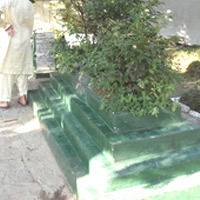Sayyid Ahmed Brelvi (Syed Ahmed Barelvi) was born in November 1786 in Rai Bareli, a town in Alahabad province in Northern India. His father Sayyid Mohammad Irfan (Syed Mohammad Irfan) was a pious and religious man who lived in Lakhnau but in his last age had settled in Bareli. At home Sayyid Ahmad (Syed Ahmed) became well versed in Arabic and Persian. He began his career as a sawar in the army of Nawab Amir Khan who later founded the State of Tonk. After gaining military experience he left for Delhi and under the tutoring of Shah Abdul Aziz joined Shah Waliullah’s family whose scholarly and dedicated services for Islam are unparalleled in the history of the subcontinent. Sayyid Ahmad Brelvi (Syed Ahmed Barelvi), indeed, made his own contribution that was singular owing to his remarkable organizing ability, practical experience of men and matters, great spiritual powers, and adequate knowledge of military acumen with which he organized a movement of Jihad. In Delhi, he was an impressive preacher and had a great circle of disciples that further enhanced when Shah Abdul Aziz’s nephew Shah Ismail and son-in-law, Maulvi Abdul Haiy joined him whole-heartedly. In 1818, with the help of these two learned disciples, he published Sirat-i-Mustaqim (straight path) leading to Islam pure in its form and free from all failing and flaws. During a visit to Rampur, he decided to perform Hajj and then conduct jihad against the Sikhs who had been committing large-scale persecution of Muslims. Accompanied by Shah Ismail, Maulvi Abdul Haiy and a large number of admirers and devotees, Sayyid Ahmad visited Allahabad, Benares, Patna, Calcutta and other cities to invite the people for Jihad. All along the way, hundreds of thousands of people responded enthusiastically to his call for Jihad before he left for Hajj by sea in 1821. After three years, the party returned to Delhi again via Calcutta in order to launch his movement for Jihad with full preparations.
In December 1826 Sayyid Ahmed Brelvi headed towards Punjab that was extended up to NWFP and ruled by Raja Ranjit Singh. At Akora Khatak he defeated a big army of Sikhs under the command of Ranjit Singh’s cousin, General Budh Singh. Having suffered heavy losses the Sikhs were too demoralized to keep hold of Akora. This victory induced many tribal chiefs to join or support Sayyid Ahmed Brelvi. Yar Muhammad Khan, the governor of Peshawar, conceded to respect the territories of Yousafza’is and exempt them from revenue-collecting raids. On 11th January 1827 he was selected Amir-ul-Momineen and within two months the number of Mujahideen reached up to 80 thousands. Although the financial conditions of the Mujahedeen became worst and the right hand of Sayyid Ahmed Maulana Abdul Hai died, he kept on fighting against the Sikhs. Ranjit Singh sent an emissary to him which offered him truce on the condition that he would rule on the left side of river Abasin but not bother about the right side, but he declined the offer. Ranjit Singh made Yar Muhammad Khan his allay, and a conflict between Yar Mohammad and Sayyid Ahmad at length resulted in the death of Yar Muhammad. His brother Sultan Mohammad asked for amnesty from Saiyid Sahib. After the conquest of Peshawar Sayyid Sahib implemented Shariah in the city. Drugs and the wrong social rituals were banned. These reforms were publicized as negative activities by the opponents of Sayyid Sahib. Sultan Mohammad Khan who had not forgotten the death of his brother provoked the local tribesmen with the result that all his deputies in Yousafzai villages were assassinated. Their assassination was a great setback that forced him to surrender Peshawar in favor of Sultan Muhammad Khan. Meanwhile, when he left for Hazara, he was left with a few faithful companions. Eventually, he was defeated and killed with his six hundred followers while fighting with the Sikhs in May 1831 at Balakot, a small town in the subdivision of Mansehra.
Though Sayyid Sahib’s jihad movement apparently came to an end, yet it left lasting impressions in distant corners of the subcontinent. The scene of his activities on the Afghan frontiers continued to attract mujahideen who caused huge afflictions to Sikhs and later to the British government. The effect of his activities further spread in Bengal where he had enrolled a number of volunteers. They continued to work after him and effectively established centers of the jihad movement.
This article was last updated on Wednesday, Jan 04, 2006






